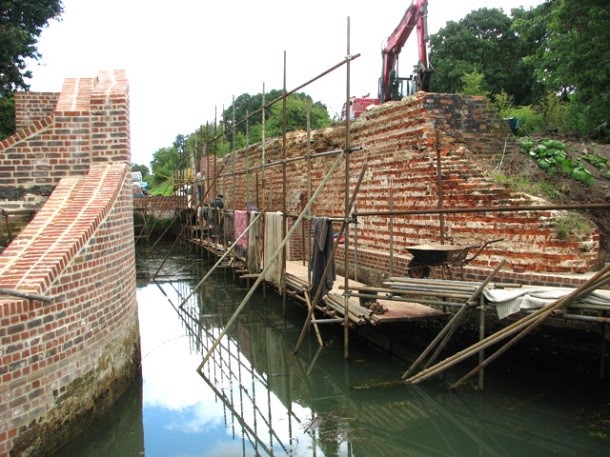The North Walsham and Dilham Canal opened in 1826, is Norfolk’s only artificial, locked sailing canal, although it included towpaths along its whole length, these were designed so that the boats could be hauled by man rather than horse. Except from Tonnage Bridge to Honing Lock, none of these towpaths are rights of way.
8¾ miles in length, it ran from Antingham Bone Mills, to Wayford Bridge where it joined the navigable River Ant. Short branches were built to serve Bacton Mill, Meeting Hill, Briggate (for Worstead), Honing Staithe, Dilham Mill and East Ruston.
It used 6 large locks along its length to enable the 20 ton wherries to ascend the 58ft rise to Antingham. The locks at Swafield (2), Bacton Wood, Ebridge, Briggate and Dilham (Honing), were each 50′ long x 12’4″ wide and 3’ x draught.
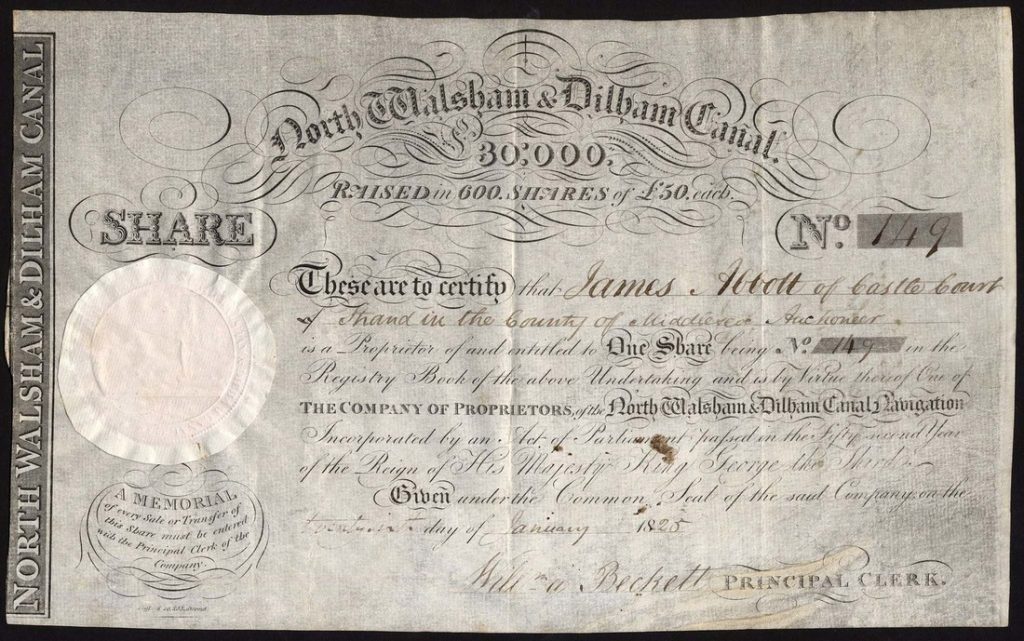
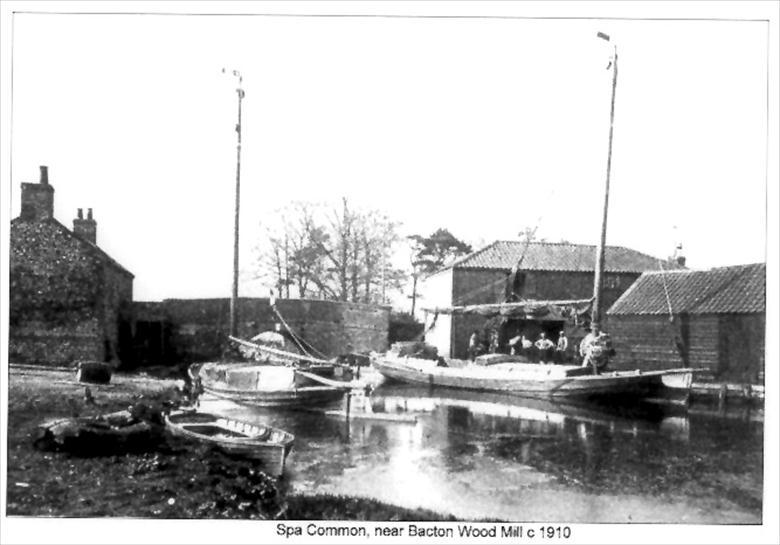
History
Prior to the canal being built, the River Ant was navigable up to Dilham water mill, at the southern end of Dilham Broad. The River Ant was an ancient navigation, but northward from Wayford it took a somewhat roundabout course, including a big meander to the east of the present canal, this also included a public staithe at East Ruston, later replaced by the East Ruston Branch and new staithe. In 1810, the promoters of the canal decided to bypass the loop, proposing a new cut running several hundred yards north of Wayford Bridge, and to improve the remainder of the route up to Honing Lock, which needed to bypass Dilham Water mill.
1811 – At a meeting held, under the presidency of Lord Suffield, at the King’s Arms Inn, North Walsham, it was resolved that the county members be requested to petition Parliament for a Bill for making a canal from Wayford Bridge to Lingate Common.
1824 – A meeting was held at the King’s Arms Inn, North Walsham, at which it was resolved to commence the construction of the North Walsham and Dilham Canal. The previous planned route had now been changed with Lord Suffield’s Antingham Bone mills being the terminus and connecting with all the mills’ millponds.
April 1825 – One hundred ‘bankers’ from Bedfordshire arrived at North Walsham and commenced digging the North Walsham and Dilham Canal. The first spade of earth was taken out by Mr. William Youard, with a band striking up ‘God save the King’.
June 1826 – The canal cost £32,000 to build and the first laden wherries proceeded along the canal from Wayford Bridge to Mr. Cubitt’s mill at North Walsham, with music playing and flags flying. Thousands of spectators assembled to witness this interesting scene, and the day ended with a treat to the workmen of Mr. Sharpe’s strong ale and Barclay’s brown stout.
August 1826 – The North Walsham and Dilham Canal was formally opened by a grand procession of vessels carrying Lord Suffield and many of the principal residents in the district, accompanied by a band of music. This started from Wayford Bridge and at Antingham the company landed, formed in procession, and marched to North Walsham, where a dinner was held at the King’s Arms Inn, under the presidency of Col. the Hon. John Wodehouse.
Although built for the carriage of coal, it remained cheaper to transport this overland from the coast. However corn, flour, timber, cattle cake and animal feedstuffs became important cargoes and included the ‘cabbage wherry’ from Antingham to Yarmouth market.
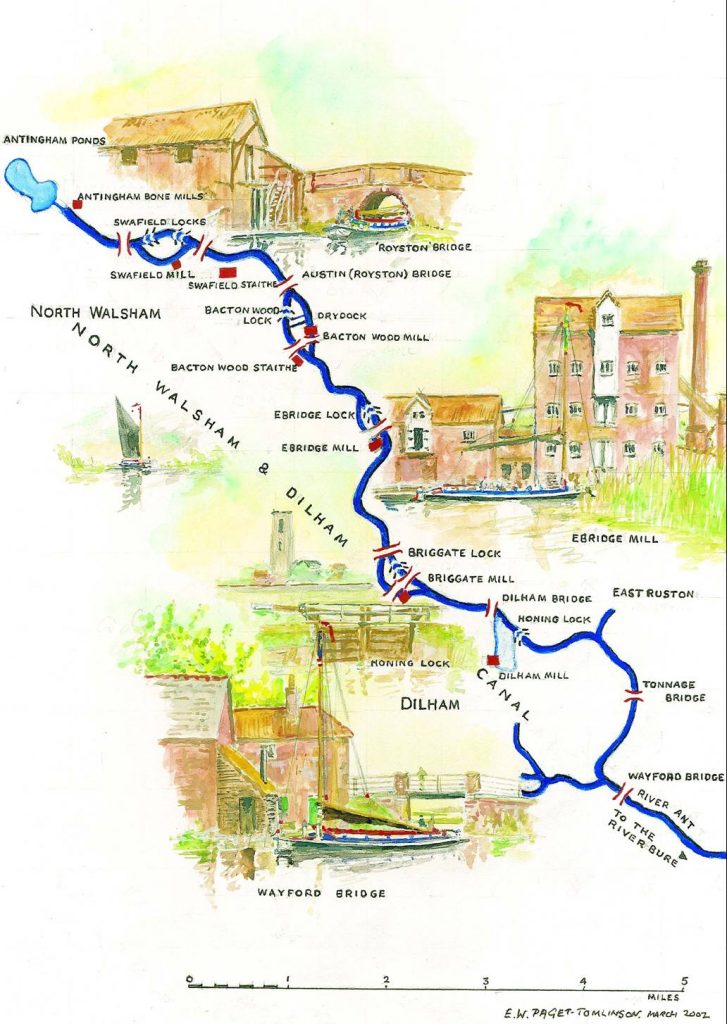
www.nwdct.org
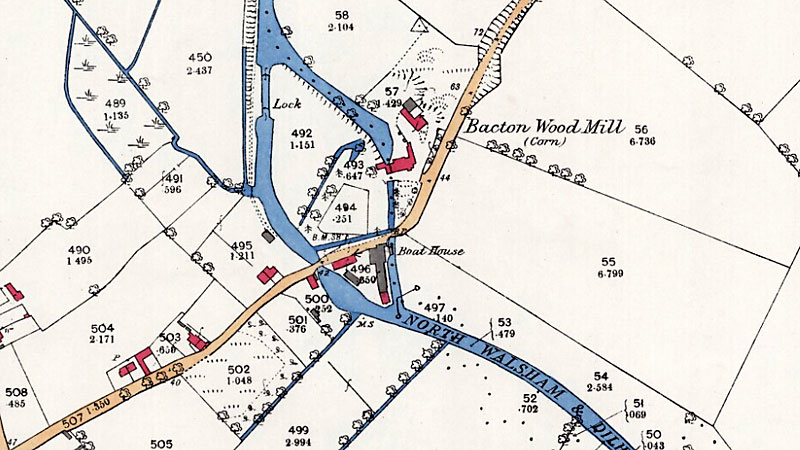
Key events in the canal’s history
1886 – 16th March the Canal was sold to Edward Press of Bacton Wood Mill for £600. The committee entrusted James Turner with distributing this to the known holders of 446 shares, but he absconded with the money after paying out only 55 shares.
1874 some of the first pleasure wherries, converted from commercial craft, were based on the canal.
1893 – Trade on the canal was low and Trade at the top end of the Canal transferred to rail as a result the section from Swafield Locks to Antingham was closed and was officially abandoned in 1927.
1906 – on Edward Press’ death the canal was auctioned off to General Estates Ltd.for £2,250.
1921 – local Ebridge millers E.G.Cubitt and G.Walker bought the canal and set up the North Walsham Canal Co.
1912 – 26th August: Seven inches of rain fell in one day causing a major breach in the bank at Bacton Wood, whilst part of the road was washed into the canal at Ebridge. A shortage of funds prevented the Bacton Wood breach from ever being satisfactorily repaired.
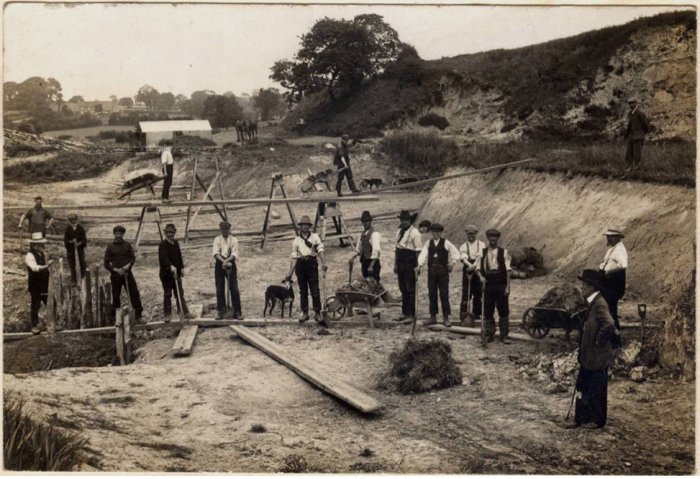
1934 – The motor wherry ‘Ella’ was the last to use the canal.
1940 – The War Department dredged the unbanked sections of the canal below Swafield, Bacton Wood, Ebridge, Briggate and above Tonnage Bridges as a defensive measure. Michael Willis (b 1939 at Briggate) recalls – During the war, the lock gates were mined. I can remember the army came and fitted a bar across to stop the bottom doors from opening, then slid big tubes of explosives into the bottom of the gates – and after the war they removed them again.
At some point in time the feed-water was diverted out of the canal above Bacton Wood Lock resulting in 900 yards of the canal becoming dry. The remainder of the canal gradually became un-navigable as the lock gates were allowed to fall into disrepair.
Today
In 1992 the East Anglian Waterways Association initiated the current restoration proposals. Meetings with various parties followed. Civil engineering lock and channel reports were produced in 1996, and an ecological report in 1998. Work parties commenced in 2001 with the aim of preventing further deterioration to the canal structures by rampant tree growth. Today the North Walsham & Dilham Canal Trust organise regular working groups to improve the canal and work alongside the canal owners.
The ‘Old Canal Co. Ltd.’ bought the top 2¼ miles of the North Walsham and Dilham Canal in 2009. The rest remains in the hands of The North Walsham Canal Co. Ltd, except for a short length at the top of the canal owned by Mr M Starling and the bottom tidally- influenced section below Honing Lock owned by Paterson Estates.
The North Walsham & Dilham Canal Trust was formed on 30th January 2008, with the aim to work with the Canal Proprietors and adjacent landowners, to protect, conserve and improve the route of the canal and its branches, for the benefit of the community and environment, promoting access to the navigation for all.
Visit the Trust’s website www.nwdct.org for more information
